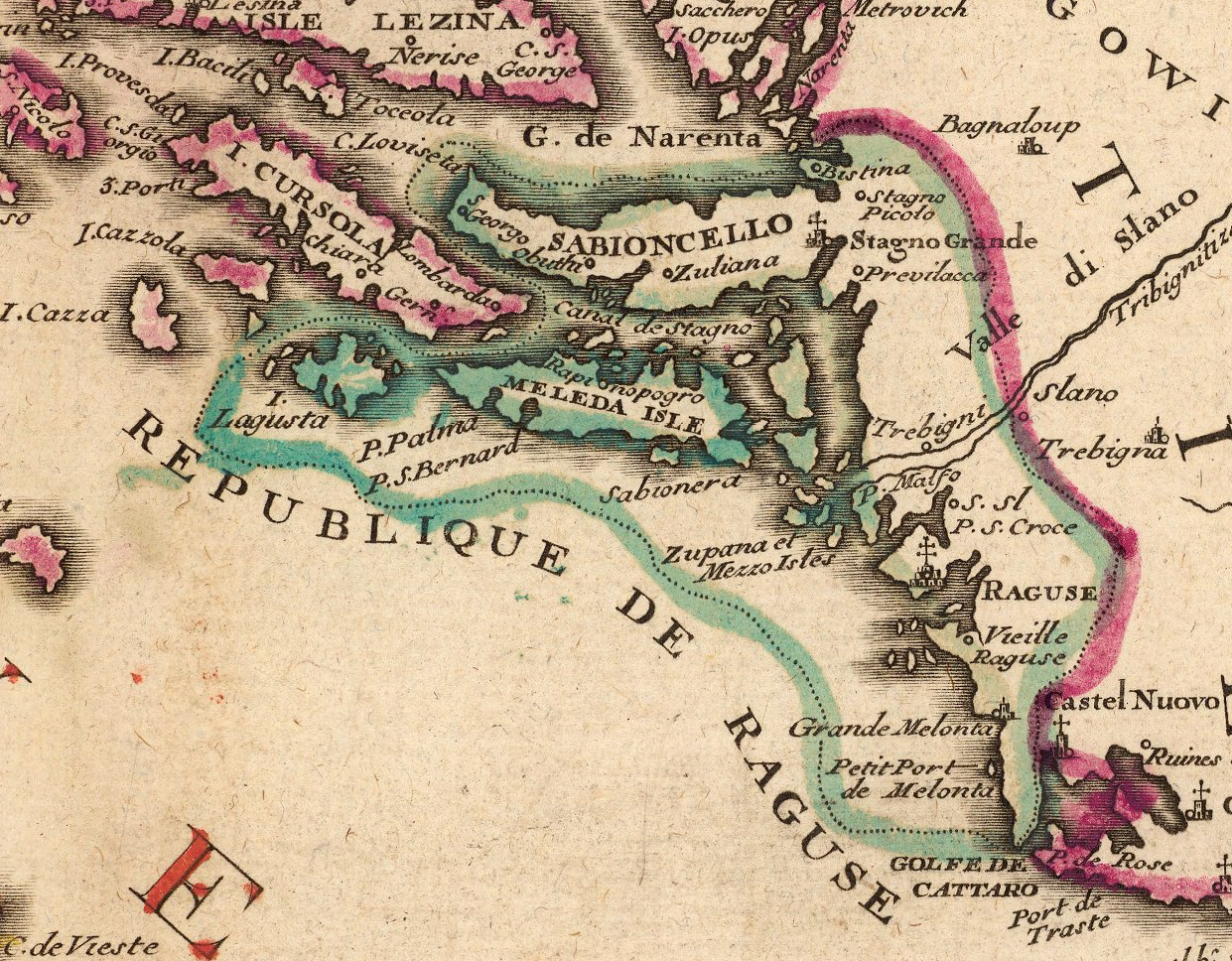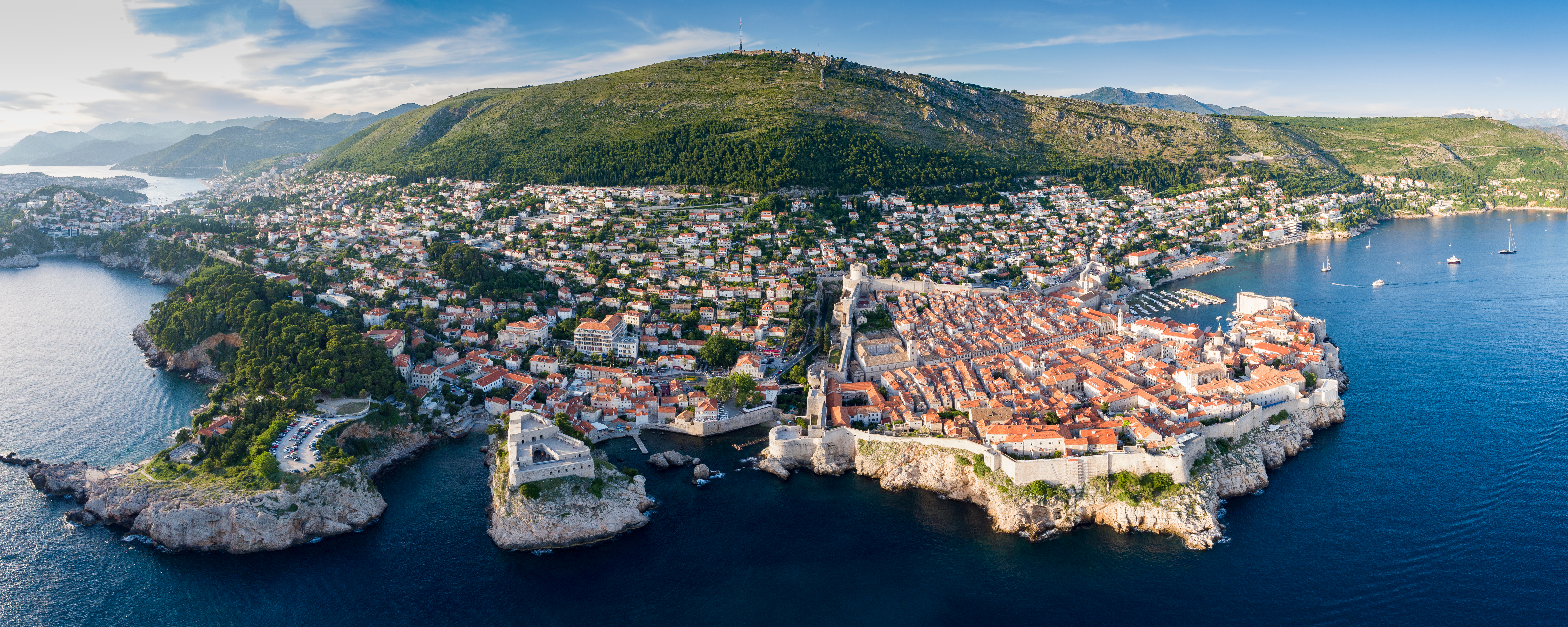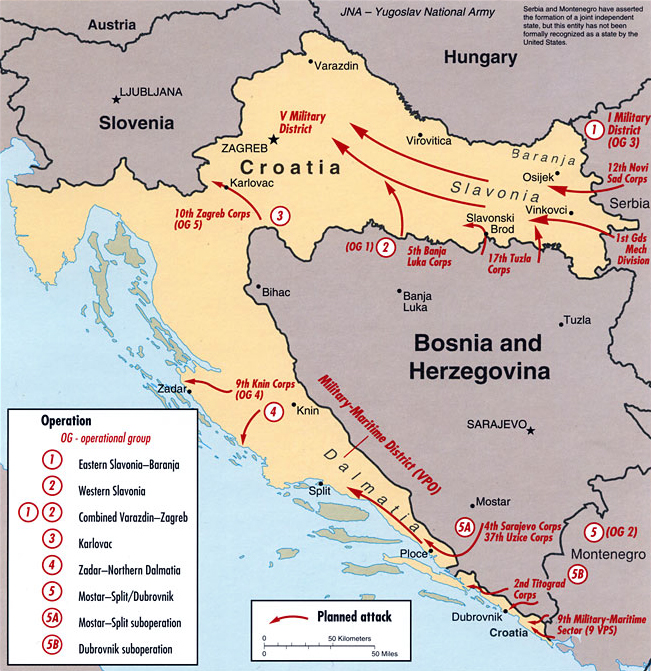|
Šipan
┼áipan (), nicknamed the Golden Island, is an island located in southern Croatia, more specifically in the Dubrovnik-Neretva County. It is located northwest of Dubrovnik, and is separated from the mainland coast by the Kolo─ıep Channel, which has an area of . The island is in length, and up to in width. It is a part of the Elaphiti Islands, and is the largest island in the archipelago. The name of the archipelago comes from the Ancient Greek word for deer (), which, according to Pliny the Elder, used to inhabit the Elaphiti Islands in large numbers. There is, however, no evidence of deer ever inhabiting the archipelago. ┼áipan's population was 476 as of 2021, an increase from the 416 people in 2011. Its highest point, the Velji Vrh, lies at above sea level, and is located in the northwestern part of the island. The Velji Vrh is one of two limestone crests, the other being the Kameni Luk, located in the southeast. Fruits such as oranges and other citrus are cultivated on ... [...More Info...] [...Related Items...] OR: [Wikipedia] [Google] [Baidu] |
Elaphiti Islands
The Elaphiti Islands or the Elaphites ( or ''Elafiti'') is a small archipelago consisting of several islands stretching northwest of Dubrovnik, in the Adriatic Sea. by Jonathan Bousfield The Elaphites have a total land area of around and a population of 850 inhabitants. The islands are covered with characteristic Mediterranean evergreen vegetation and attract large numbers of tourists during the summer tourist season due to their beaches and pristine scenery. Roman author was the first to mention the islands by the name Elaphiti Islands ( or Deer Archipelago) in his work '' |
Dubrovnik
Dubrovnik, historically known as Ragusa, is a city in southern Dalmatia, Croatia, by the Adriatic Sea. It is one of the most prominent tourist destinations in the Mediterranean Sea, Mediterranean, a Port, seaport and the centre of the Dubrovnik-Neretva County. In 2021, its total population was 41,562. Recognizing its outstanding medieval architecture and fortifications, UNESCO inscribed the Old City of Dubrovnik as a World Heritage Site in 1979. The history of the city probably dates back to the 7th century, when the town known as was founded by refugees from Epidaurum (). It was under protectorate of the Byzantine Empire and later under the sovereignty of the Republic of Venice. Between the 14th and 19th centuries, Dubrovnik ruled itself as a Free state (polity), free state. The prosperity of the city was historically based on trade, maritime trade; as the capital of the maritime Republic of Ragusa, it achieved a high level of development, particularly during the 15th and 16t ... [...More Info...] [...Related Items...] OR: [Wikipedia] [Google] [Baidu] |
Republic Of Ragusa
The Republic of Ragusa, or the Republic of Dubrovnik, was an maritime republics, aristocratic maritime republic centered on the city of Dubrovnik (''Ragusa'' in Italian and Latin; ''Raguxa'' in Venetian) in South Dalmatia (today in southernmost Croatia) that carried that name from 1358 until 1808. It reached its commercial peak in the 15th and the 16th centuries, before being conquered by Napoleon's First French Empire, French Empire and formally annexed by the Kingdom of Italy (Napoleonic), Napoleonic Kingdom of Italy in 1808. It had a population of about 30,000 people, of whom 5,000 lived within the city walls. Its motto was "'", a Latin phrase which can be translated as "Liberty is not well sold for all the gold". Names Originally named ' (Latin for "Ragusan municipality" or "community"), in the 14th century it was renamed ' (Latin for ''Ragusan Republic''), first mentioned in 1385. It was nevertheless a Republic under its previous name, although its Rector was appointed b ... [...More Info...] [...Related Items...] OR: [Wikipedia] [Google] [Baidu] |
Šipanska Luka
Šipanska Luka is a village in Croatia, located on the western coast of Šipan which is one of the Elaphiti Islands. Demographics According to the 2021 census, its population was 254. References Populated places in Dubrovnik-Neretva County {{DubrovnikNeretva-geo-stub ... [...More Info...] [...Related Items...] OR: [Wikipedia] [Google] [Baidu] |
Battle Of Tauris
The Battle of Tauris was a naval battle during Caesar's civil war in which a Pompeian fleet led by Marcus Octavius was defeated by a Caesarian fleet led by Publius Vatinius operating off the coast of Dalmatia. Background Caesar's civil war began on 10 January 49 BC. Caesar would go on to conquer Italy, Hispania, Sardinia, Corsica, and Sicilia, before invading Macedonia. During the invasion of Greece, Caesar faced a setback at Dyrrhachium before eventually defeating Pompey at the Battle of Pharsalus. Pompey fled to Egypt, where he was assassinated by the Egyptians in an attempt to appease Caesar. Caesar then intervened in the Egyptian civil war, deciding to help the Egyptian pharaoh Cleopatra to the throne and defeating her younger brother Ptolemy XIII in the Battle of the Nile. Prelude By 47 BC, Octavius returned to the region with another fleet and began to blockade several Dalmatian ports, inflicting severe damage on the Caesarean shipping process. Octavius's ar ... [...More Info...] [...Related Items...] OR: [Wikipedia] [Google] [Baidu] |
Su─æura─æ
Suđurađ (locally known and pronounced as Suđurac) is a village in Croatia, located on the eastern coast of Šipan which is one of the Elaphiti Islands The Elaphiti Islands or the Elaphites ( or ''Elafiti'') is a small archipelago consisting of several islands stretching northwest of Dubrovnik, in the Adriatic Sea. References Populated places in Dubrovnik-Neretva County {{DubrovnikNeretva-geo-stub ...[...More Info...] [...Related Items...] OR: [Wikipedia] [Google] [Baidu] |
Lopud
Lopud () is a small island off the coast of Dalmatia, southern Croatia. Lopud is economically the most developed of the Elaphiti Islands, and can be reached by boat from Dubrovnik, Trsteno, Ora┼íac and Zaton. The island is famous for its sandy beaches, in particular the bay of ┼áunj. Lopud is the second largest island of the Elaphiti islands, between Kolo─ıep and ┼áipan. It is famous as the "island in the middle" (Insula Media, or Mezzo). It has an area of and its highest point is Pola─ıica, above sea level Height above mean sea level is a measure of a location's vertical distance (height, elevation or altitude) in reference to a vertical datum based on a historic mean sea level. In geodesy, it is formalized as orthometric height. The zero level .... It has of coastline, of which is sandy. History The central island known as Elaphite (Deer) archipelago 7 NM away from Dubrovnik and with an area of 4.6 square km was a frequent station of ancient Greeks and later ... [...More Info...] [...Related Items...] OR: [Wikipedia] [Google] [Baidu] |
Dubrovnik-Neretva County
The Dubrovnik-Neretva County (; , ) is the southernmost county of Croatia. The county seat is Dubrovnik and other large towns are Kor─ıula, Metkovi─ç, Opuzen and Plo─ıe. The Municipality of Neum, which belongs to neighbouring Bosnia and Herzegovina, divides the county in two parts which are connected only by the Pelje┼íac Bridge. The southern part of the county consists of Dubrovnik and the surrounding area, including the Pelje┼íac peninsula, and the islands of Kor─ıula, Lastovo, Mljet, ┼áipan, Lopud and Kolo─ıep. The northern part of the county includes the Neretva Delta, the Ba─çina lakes north of Plo─ıe, and a swath of hinterland near the southernmost slopes of Biokovo and around the hill of Rujnica. The northern part of the Mljet island is a national park. The Lastovo archipelago is a designated nature park. The southernmost tip of the county is the Prevlaka peninsula at the border with Montenegro. It is the only Croatian county that borders Montenegro. The ... [...More Info...] [...Related Items...] OR: [Wikipedia] [Google] [Baidu] |
Zadar
Zadar ( , ), historically known as Zara (from Venetian and Italian, ; see also other names), is the oldest continuously inhabited city in Croatia. It is situated on the Adriatic Sea, at the northwestern part of Ravni Kotari region. Zadar serves as the seat of Zadar County and of the wider northern Dalmatian region. The city proper covers with a population of 75,082 , making it the second-largest city of the region of Dalmatia and the fifth-largest city in the country. Today, Zadar is a historical center of Dalmatia, Zadar County's principal political, cultural, commercial, industrial, educational, and transportation centre. Zadar is also the episcopal see of the Archdiocese of Zadar. Because of its rich heritage, Zadar is today one of the most popular Croatian tourist destinations, named "entertainment center of the Adriatic" by ''The Times'' and "Croatia's new capital of cool" by ''The Guardian''. UNESCO's World Heritage Site list included the fortified city of Zadar ... [...More Info...] [...Related Items...] OR: [Wikipedia] [Google] [Baidu] |
Yugoslav People's Army
The Yugoslav People's Army (JNA/; Macedonian language, Macedonian, Montenegrin language, Montenegrin and sr-Cyrl-Latn, ºêªâº│º¥ªüº╗º¥º▓ºÁº¢ªüº║º░ º¢º░ªÇº¥º┤º¢º░ º░ªÇº╝º©ªİº░, Jugoslovenska narodna armija; Croatian language, Croatian and ; , JLA), also called the Yugoslav National Army, was the military of the Socialist Federal Republic of Yugoslavia and its antecedents from 1945 to 1992. Origins The origins of the JNA started during the Yugoslav Partisans of World War II. As a predecessor of the JNA, the People's Liberation Army of Yugoslavia (NOVJ) was formed as a part of the Resistance during World War II, anti-fascist World War II in Yugoslavia, People's Liberation War of Yugoslavia in the Bosnian town of Rudo on 22 December 1941. After the Yugoslav Partisans liberated the country from the Axis Powers, that date was officially celebrated as the "Day of the Army" in the Socialist Federal Republic of Yugoslavia (SFR Yugoslavia). In March 1945, the NOVJ was renamed the "Yugo ... [...More Info...] [...Related Items...] OR: [Wikipedia] [Google] [Baidu] |
Siege Of Dubrovnik
The siege of Dubrovnik ( sh-Latn-Cyrl, opsada Dubrovnika, º¥º┐ªüº░º┤º░ ºöªâº▒ªÇº¥º▓º¢º©º║º░) was a military engagement fought between the Yugoslav People's Army (JNA) and Croatian forces defending the city of Dubrovnik and its surroundings during the Croatian War of Independence. The JNA started its advance on 1 October 1991, and by late October, it had captured virtually all the land between the Pelje┼íac and Prevlaka peninsulas on the coast of the Adriatic Sea, with the exception of Dubrovnik itself. The siege was accompanied by a Yugoslav Navy blockade. The JNA's bombardment of Dubrovnik, including that of the Old TownÔÇöa UNESCO World Heritage SiteÔÇöculminated on 6 December 1991. The bombardment provoked international condemnation, and became a public relations disaster for Republic of Serbia (1990ÔÇô2006), Serbia and Socialist Republic of Montenegro, Montenegro, contributing to their diplomatic and economic isolation, as well as the international recognition of independenc ... [...More Info...] [...Related Items...] OR: [Wikipedia] [Google] [Baidu] |
Homeland War
The Croatian War of Independence) and (rarely) "War in Krajina" ( sr-Cyrl-Latn, ºáº░ªé ªâ ºÜªÇº░ªİº©º¢º©, Rat u Krajini) are used. was an armed conflict fought in Croatia from 1991 to 1995 between Croats, Croat forces loyal to the Government of CroatiaÔÇöwhich had declared Independence of Croatia, independence from the Socialist Federal Republic of Yugoslavia (SFRY)ÔÇöand the Serbs, Serb-controlled Yugoslav People's Army (JNA) and Serbs of Croatia, local Serb forces, with the JNA ending its combat operations by 1992. A majority of Croats supported Croatia's independence from Yugoslavia, while many ethnic Serbs living in Croatia, supported by Republic of Serbia (1992ÔÇô2006), Serbia, opposed the secession and advocated Serb-claimed lands to be in a common state with Serbia. Most Serbs sought a new Serb state within a Yugoslav federation, including areas of Croatia and Bosnia and Herzegovina with ethnic Serb majorities or significant minorities, and attempted to conquer as muc ... [...More Info...] [...Related Items...] OR: [Wikipedia] [Google] [Baidu] |






